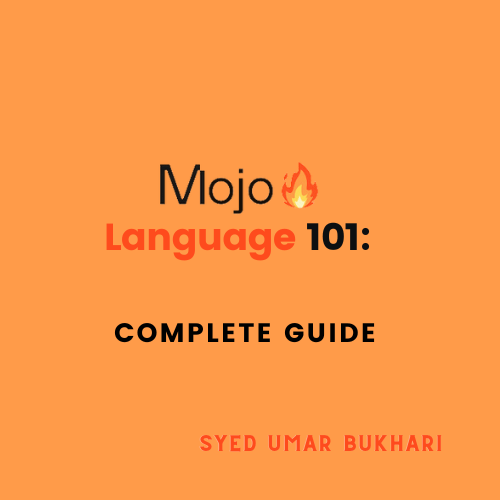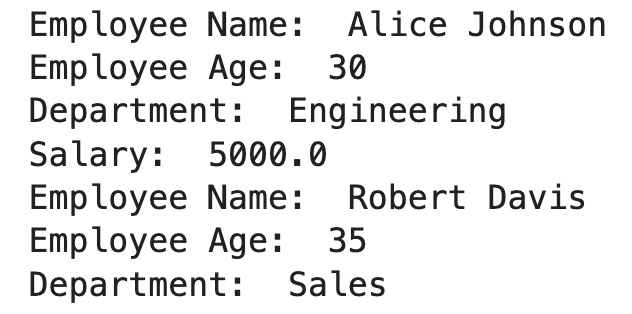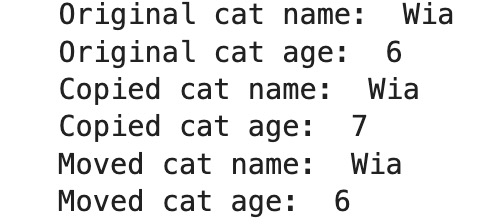Ever feel like you’re swimming against the tide, striving to make sense of the growing complexities and progress of artificial intelligence development? In our turbocharged, competitive world, the mantra is clear: adapt, improve, and excel. Based on this, Mojo language, the innovative programming language designed explicitly for AI development, entered the frame (just over a month ago)!

In this article, we’ll dissect the Mojo language and its technical wizardry with carefully crafted examples that will highlight its key features. For your help, you can visit this GitHub link to access all the code used for this article. Get ready to unveil why Mojo could be the ace up your sleeve for your next big venture in the field of AI.
Presenting the Mojo Language: Overview and Context
Are you prepared to elevate your AI development capabilities to new heights? Before you can do that, knowing what you’re getting yourself into is essential, right?
Let’s begin exploring the new Mojo programming language!
Understanding Mojo language is more than learning its syntax—it’s about exploring the philosophy behind its creation. The team at Modular crafted this language with an emphasis on performance, modularity (pun intended), and interoperability.
Do you want to start using Mojo language to follow along? Remember, you have to sign up here to get started. It took me under two weeks to access the Mojo playground (where you can currently code in Mojo). So, sign up soon if the Mojo language fascinates you. I know people who got in just a day after queuing up!
Whether you’re a beginner or an experienced programmer, Mojo has the potential to revolutionize your approach to AI development, thanks to its innovative features and intuitive syntax. This language aims to run efficiently and promote clean and organized codebases. But what makes it unique?
Understanding the Mojo Language: What Sets It Apart?
Mojo language, created for AI tasks and system programming by unifying the AI/ML infrastructure, is a testament to Modular’s acute attention to detail. It simplifies the intricacies often linked with AI programming. As such, Mojo language aims to be a complete superset of Python, but it’s not there yet.
The goal of the Mojo language is innovation. To target accelerators and provide a language with robust compile time metaprogramming, caching and other prevalent modern features.
Mojo boasts dynamic and static typing, affording programmers the flexibility to switch their coding styles as per their needs. The syntax of Mojo language is intuitive and designed with programmers in mind, further simplifying the process of getting started.
This paves the way for swift and efficient coding, reducing the time taken to transform ideas into functional AI models. What’s more is that it also works seamlessly with different systems and languages, increasing its versatility in diverse development environments.
And you must sign up to get in the queue to access the Mojo Playground by Modular. The Mojo language is not publicly released yet.
In the next section, we will examine some of its main features, assuming you have access to Mojo language.
Why Mojo Programming: A Look at its Key Features
Mojo aims to bridge the gap between Python’s functionality and C++’s execution performance. It also aims to be a superset of Python, meaning it will eventually support all Python code.
Let’s see some of the key Mojo language features:
- Expressiveness: Mojo language supports dynamic and static typing and features a rich standard library.
- Concurrency: It has built-in features to support concurrent and distributed computing.
- Modularity: Mojo’s architecture encourages modular design, allowing you to maintain codebases efficiently.
- Interoperability: Mojo is highly compatible, allowing it to interact with different systems and programming languages, especially Python.
- Performance: The language aims to deliver high performance, enabling rapid development and ease of use.
- Mojo’s ? Extension: While the file extension makes no difference to Mojo’s features, how cool is an emoji for a coding file extension?
With the features out of the way, it’s time to dive into the meat of things truly: the anatomy of the Mojo language.
The Anatomy of the Mojo Language: A Practical Guide to Writing Code
It’s vital to know the key elements that form the core structure of the Mojo programming language. Since it supports a lot of existing Python syntax, you can still do something like this and have it work:
print("Hello Mojo")
But that said, let’s explore Mojo language’s anatomical features:
let and var declaration in Mojo:
let and var are part of the Mojo language’s motto of adding strong type-checking to variable data types. You could say the JavaScript inspiration is obvious here. Still, both types:
- Create a new scoped runtime value.
- Support name shadowing, allowing variables in inner scopes to have the same name as variables in outer scopes.
- Can include type specifiers, patterns, and late initialization.
Difference between let and var :
Aside from these similarities, there is a crucial difference between let and var in Mojo:
- Variables declared with
varare mutable, allowing their values to be modified after assignment. - Variables declared with
letare immutable, meaning their values cannot be changed once assigned.
Here’s an example to highlight the features of both:
def bookstore_management(new_books, sold_books):
# Declaring an immutable variable 'total_books' with 'let'
let total_books = new_books
print("Total books:")
print(total_books)
# Uncommenting the next line would result in an error because 'total_books' is immutable
# total_books = total_books - 40 # error: 'total_books' is immutable
# Declaring a mutable variable 'current_books' with 'var'
var current_books = new_books
print("Current books:")
print(current_books)
# Selling some books and reducing the current_books number
current_books = current_books - sold_books
print("Current books after reduction:")
print(current_books)
# Both 'let' and 'var' support name shadowing and lexical scoping
if total_books != current_books:
let total_books = current_books
print("Total books with lexical scoping, declared inside nested scope:")
print(total_books)
print("Total books in bookstore management function is still:")
print(total_books)
def run_bookstore():
# Received 100 new books
new_books = 100
# Sold 20 books
sold_books = 20
bookstore_management(new_books, sold_books)
run_bookstore()
In the bookstore_management function, we create the total number of books initially as an immutable value using let. Afterward, we create a mutable variable current_books using var, which can be changed when books are sold.
This is how the output looks:

If you try to uncomment the line above, this is the error you will see:

The concept of name shadowing and lexical scoping allows you to create new variables (in the if scope) with the same names as outer variables within nested scopes. This variable shadows the total_books declared at the start of the function, showcasing the shadowing concept in lexical scoping. It prevents unintended interference between variables of the same name in different scopes.
Here is another Mojo code example which mainly highlights these other features:
def bookstore_management(new_books: Int, sold_books: Int):
# Declaring an immutable variable 'total_books' with 'let'
let total_books: Int = new_books
print("Total books in store:", total_books)
# Declaring a mutable variable 'current_books' with 'var'
var current_books: Int = new_books
print("Current books in store:", current_books)
# Selling some books and reducing the current_books number
current_books = current_books - sold_books
print("Current books after selling:", current_books)
# Both 'let' and 'var' support name shadowing and lexical scoping
if total_books != current_books:
let total_books: Int = current_books
print("Total books with lexical scoping, declared inside nested scope:", total_books)
# Late initialization and pattern matching
let discount_rate: F64
let book_id: Int = 123
if book_id == 123:
discount_rate = 0.2 # 20% discount for mystery books
else:
discount_rate = 0.05 # 5% discount for other book categories
print("Discount rate for Book with ID ", book_id, "is:", discount_rate)
def run_bookstore():
# Received 100 new books
let new_books: Int = 100
# Sold 20 books
let sold_books: Int = 20
bookstore_management(new_books, sold_books)
run_bookstore()Here’s the updated output:

Type specifiers:
The type of each variable is explicitly specified using type specifiers (Int for integers and F64 for floating-point numbers). This ensures clarity and allows the compiler to enforce type safety.
Late initialization and pattern matching:
discount_rate demonstrates late initialization, where the value of a variable is determined based on a condition after its declaration with let. It is assigned a value later based on the book_category using conditional statements (if, elif, and else) –> pattern matching. Access out all the code here.
Notes:
- I had trouble printing a string and variable inside one print statement in the first example, so I had to improvise and you two different print statements. Despite trying various string concatenation and type conversion approaches, I couldn’t get it to print the variable and string together. However, it was an isolated incident, and I couldn’t get it to replicate.
- I am still determining all the data types specified by Mojo language. I tried STR for strings and I32 for integers, but both did not exist. But then with some research, I learned about a few other types in Mojo language other than Int and Float:
- SI (signed integer — from the Mojo docs),
- UI (unsigned integer), and
- String (if you add this line at the top: from String import String).
- UPDATE: Here is an indirect link which specifies the data type specifiers in Mojo.
Structures in Mojo Language:
Mojo language also supports structures, like in C++. A struct is a custom data structure that groups related variables of different data types into a single unit that holds multiple values. Functional programming languages commonly use them as lightweight alternatives to classes for creating custom data types, such as in C and C++, as they bind at compiler-time.
What are Structs in Mojo Language?
Structs in Mojo structs provide a way to organize and manage data, encapsulate attributes, and improve code organization and reusability.
- Structs in Mojo have a static structure, and you cannot modify them at runtime like Python classes, offering performance benefits and safety.
- Like Python classes, structs support methods, fields, operator overloading, and metaprogramming.
- All instance properties in a struct must be explicitly declared with
varorlet. (right now onlyvaris supported) - All standard data types, like Int, String, Bool, etc., make use of structs in Mojo.
Here’s an example of a struct that holds employee information:
from String import String
@value
struct Employee:
var name: String
var age: Int
var department: String
var salary: F64
def print_employee_details(employee: Employee):
print("Name:", employee.name)
print("Age:", employee.age)
print("Department:", employee.department)
print("Salary:", employee.salary)
# Create employee instances
employee1 = Employee("Alice Thompson", 30, "Engineering", 5000.0)
employee2 = Employee("Robert Davis", 35, "Sales", 4500.0)
# Print employee details
print_employee_details(employee1)
print_employee_details(employee2)In this example, we define an Employee struct with properties such as name, age, department, and salary. Then, we create two instances of the Employee struct with different values for each property. The print_employee_details function prints the details of these two instances of the struct as you cannot directly print out a struct yet in Mojo.
The struct helps us organize and encapsulate employee data, efficiently creating, accessing, and managing employee information. We can also add additional methods to the struct to perform operations specific to employees, such as calculating bonuses or generating reports.
This example demonstrates how structs in Mojo provide a struct(ured) and efficient way to manage and manipulate real-world entities’ data. You should know that you cannot change the structure or contents of a struct while a program is running.
Here’s the output from the code above in Mojo language:

Note: While the Mojo docs specify that you can use let and var within a struct, let is not currently supported.
Overloading: Methods, Functions and Operators in Mojo
Mojo takes on a detective role whenever it needs to resolve calls. It scrutinizes each potential method: if only one fits the bill, that’s the chosen one. If there’s more than one contender, Mojo picks the one that’s the closest match. And in the rare scenario when Mojo can’t decide, it sounds an ambiguity alert. But don’t worry, you can overcome this by adding an explicit cast at the call site.
Method Overloading within Structs in Mojo:
In Mojo, methods are functions within a struct that can operate on the instances of that struct or class, accessing or modifying the data. And when you define a method in a struct or class without specifying argument data types in Mojo language, it handles them dynamically, like Python.
Yet, Mojo takes it a step further, offering full-fledged support for method overloading when type safety is a priority. The unique aspect of this feature? You can define multiple methods, each with the same name but different arguments, all within a single struct or class. This is a powerful tool, often seen in robust languages like C++, Java, and Swift, but now in a language focused on AI development too.
Let’s expand upon our Employee example from above:
from String import String
@value
struct Employee:
var name: String
var age: Int
var department: String
var salary: F64
def print_details(self) -> None:
print("Employee Name: ", self.name)
print("Employee Age: ", self.age)
print("Department: ", self.department)
print("Salary: ", self.salary)
def print_details(self, include_salary: Bool) -> None:
print("Employee Name: ", self.name)
print("Employee Age: ", self.age)
print("Department: ", self.department)
if include_salary:
print("Salary: ", self.salary)
let employee1 = Employee("Alice Johnson", 30, "Engineering", 5000.0)
let employee2 = Employee("Robert Davis", 35, "Sales", 4500.0)
employee1.print_details()
employee2.print_details(False)Take the Employee struct, for instance, which sports two methods named print_details. The first one only calls for self, while the second one invites an additional Bool argument, include_salary. Now, when you want to execute print_details() on an Employee instance, Mojo programming language, with its sharp judgment, selects the correct method based on the arguments you provide. Hence, this example demonstrates the concept of method overloading in Mojo.

However, I’d also like to point out that Mojo does not allow method overloading based solely on the return type. You can also check out all the code here. Let’s see how you can utilize function overloading.
Function Overloading in Mojo Language:
Mojo also natively supports function overloading and works similarly to other languages. This means that you can define multiple functions with the same name but with different arguments (type, number of arguments), and Mojo will differentiate each of them based on the function arguments.
Let’s consider the example below:
from String import String
# Function Overloading
fn print_details(name: String, age: Int) -> None:
print("Name: ", name)
print("Age: ", age)
fn print_details(name: String, age: Int, department: String) -> None:
print("Name: ", name)
print("Age: ", age)
print("Department: ", department)
# Usage example
print_details("Alice Thompson", 30)
print_details("Robert Davis", 35, "Sales")Two functions exist with the same name, but different arguments in the example above, one that takes two arguments and the other takes three arguments.

When you call these functions, Mojo picks the correct function to execute based on the number of arguments you passed.
It would be fair to wonder if method and function overloading are the same things.
Method Overloading vs Function Overloading
Note that the main difference between function overloading and method overloading lies in the context in which one uses them. Function overloading applies to standalone functions, while method overloading applies to methods within a class or struct.
Other than that, the concept is essentially the same: it allows you to define multiple pieces of code with the same name but different arguments. Mojo selects the correct one based on the arguments you provide when calling the function or method.
Let’s look at another overloading type now: operator overloading.
Operator Overloading in Mojo Programming Language:
In Mojo, you can also define operator overloading by defining methods with special names. Here we will define a __add__ method to overload the + operator, which will allow us to “add” two rectangles together by creating a new rectangle with the combined length and width:
struct Rectangle:
var length: F32
var width: F32
fn __init__(inout self, length: F32, width: F32) -> None:
self.length = length
self.width = width
print("Rectangle created with length:", self.length, "and width:", self.width)
fn area(self) -> F32:
var area: F32 = self.length * self.width
print("The area of the rectangle is:", area)
return area
fn area(self, side: F32) -> F32:
var area: F32 = side * side
print("The area of the square is:", area)
return area
fn perimeter(self) -> F32:
var perimeter: F32 = 2 * (self.length + self.width)
print("The perimeter of the rectangle is:", perimeter)
return perimeter
fn __add__(self, other: Rectangle) -> Rectangle:
return Rectangle(self.length + other.length, self.width + other.width)
var rect1 = Rectangle(10.0, 15.0)
var rect2 = Rectangle(5.0, 7.0)
var squareArea: F32 = rect1.area(10.0)
var rect3 = rect1 + rect2Note that this example also highlights method overloading. Also, do you see that we can add two rectangle objects together even though you couldn’t do that natively? This is due to operator overloading for addition.

The output above shows that Mojo also provides intuitive warnings that help you optimize your code. I used var instead of let for a variable that never changed in the program. Instead, I should have used let.
Decorators in Mojo Language: What’s the Purpose?
Decorators are a powerful feature in many programming languages that allows you to modify the behavior of a function, method or class without changing its source code. This is known as metaprogramming, since a part of the program tries to modify another part of the program at compile time.
In the context of Mojo programming language, decorators modify the properties and behaviors of types (like structs) and functions.
List of Decorators in Mojo Language:
Here is a brief list of decorators in Mojo language:
@register_passable: This decorator is used to specify that a struct can be passed in a register instead of passing through memory. This can lead to more efficient code.@register_passable("trivial"): This decorator is a variant of@register_passablefor trivial types, indicating that the type is both register passable and has no user-defined copy/move/destroy logic.@always_inline: This decorator in Mojo language suggests the compiler always inline the decorated function, improving the runtime performance by reducing function call overhead.@parameter: This decorator is used on nested functions that capture runtime values, creating “parametric” capturing closures.@value: This decorator is used on structs to automatically generate boilerplate code, such as initializers and copy/move constructors.
Here’s an example below to explain the @value decorator in Mojo:
@value
struct Pet:
var name: String
var age: IntBecause of the @value decorator, these boilerplate functions are automatically created for the above struct:
fn __init__(inout self, owned name: String, age: Int):
self.name = name^
self.age = age
fn __copyinit__(inout self, existing: Self):
self.name = existing.name
self.age = existing.age
fn __moveinit__(inout self, owned existing: Self):
self.name = existing.name^
self.age = existing.age
As a result, you can directly write the code below:
from String import String
@value
struct Pet:
var name: String
var age: Int
# Creating a new pet
var myCat = Pet("Wia", 6)
print("Original cat name: ", myCat.name)
print("Original cat age: ", myCat.age)
# Copying a pet
var copiedCat = Pet(myCat.name, 7)
print("Copied cat name: ", copiedCat.name)
print("Copied cat age: ", copiedCat.age)
var movedCat = myCat
print("Moved cat name: ", movedCat.name)
print("Moved cat age: ", movedCat.age)
So decorators in Mojo do not only enhance the functionality but also make the Mojo language more intuitive to use. Here is the code output:

Do you see how much more efficient this is? And there’s one more crucial thing to know about Mojo…
Arguments Behavior in Mojo Functions
In programming, when calling a function or method, you use arguments to refer to the actual values on which the function or method operates. Conversely, parameters are the placeholder values within the function or method. When you define a function, you specify the arguments that it will take, along with their types.
Argument Types in Mojo Language:
- Immutable Arguments (Borrowed):
- This is the default behavior for
fnarguments in Mojo. - These are read-only arguments that a function cannot modify.
- Using
borrowedbefore the argument type is optional; it’s the default behavior. - It’s beneficial when passing large or costly values since it prevents unnecessary copies.
- This is the default behavior for
@value
struct SomethingBig:
var id: Int
fn print_id(self):
print(self.id)
fn use_something_big(borrowed a: SomethingBig, b: SomethingBig):
a.print_id()
b.print_id()
var obj1 = SomethingBig(1)
var obj2 = SomethingBig(2)
use_something_big(obj1, obj2)immutable arguments Output:
1
2
- Mutable Arguments (Inout):
- If a function needs to modify an argument, it can be declared as mutable using the
inoutkeyword. - Changes to mutable arguments are visible outside the function.
- It’s frequently used when a method needs to mutate
self.
- If a function needs to modify an argument, it can be declared as mutable using the
@value
struct Counter:
var count: Int
fn increase(inout self, amount: Int):
self.count += amount
var myCounter = Counter(0)
print(myCounter.count)
myCounter.increase(3)
print(myCounter.count)Mutable arguments Output:
0
3
- Transfer Arguments (Owned and ^):
- Used for functions that need to take exclusive ownership of a value.
- Used with the postfixed
^operator which ends the lifetime of a value binding and transfers the value ownership. - Useful when working with unique pointers or when you want to avoid copies.
@value
struct UniqueNumber:
var num: Int
def use(p: UniqueNumber):
print(p.num)
def usePointer():
let ptr = UniqueNumber(100)
take_ptr(ptr^)
def take_ptr(owned p: UniqueNumber):
use(p)
usePointer()Transfer Arguments Output:
100
- Comparison with
defarguments:- A
defargument without an explicit type annotation defaults toObject. - A
defargument without a convention keyword (such asinoutorowned) is passed by implicit copy into a mutablevarwith the same name as the argument.
- A
def example(inout a: Int, b: Int, c):
# b and c use value semantics so they're mutable in the function
...
fn example(inout a: Int, b_in: Int, c_in: Object):
# b_in and c_in are immutable references, so we make mutable shadow copies
var b = b_in
var c = c_in
...In the next article, we will compare the Mojo language and Python programming language comprehensively and focus on AI development with Mojo language.
Conclusion: The Comprehensive Beginner’s Guide to Mastering Mojo Language
In this article, we introduced Mojo, a new programming language for AI development that aims to blend Python’s functionality with C++’s performance. The language stands out for its dynamic and static typing, modularity, interoperability, and support for both concurrent and distributed computing. With a strong focus on performance and clean, organized codebases, Mojo language facilitates swift, efficient coding.
We also discussed all its key features in-depth, with practical examples. Mojo aims to be a superset of Python– it includes all of its features but adds some new ones. Stay tuned because in the next article, we’ll provide a full comparison between Mojo and Python and explore the potential of Mojo language for AI. If you want to access all the Mojo code used in this article, visit this GitHub link.
More articles on cutting-edge topics: ChatGPT AI: Features to 6X Your Productivity in 2023 and Smart Contracts in Python: Complete Guide
Written by: Syed Umar Bukhari.



